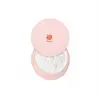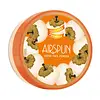What's inside
What's inside
 Key Ingredients
Key Ingredients

 Benefits
Benefits

 Concerns
Concerns

 Ingredients Side-by-side
Ingredients Side-by-side

Silica
AbrasiveTalc
AbrasiveBoron Nitride
AbsorbentDimethicone
EmollientPhenoxyethanol
PreservativeSodium Dehydroacetate
PreservativePolydiethylsiloxane
EmollientSilk Powder
Skin ConditioningAlcohol
AntimicrobialParfum
MaskingCalamine
AbsorbentPrunus Persica Fruit Extract
AbrasiveButylene Glycol
HumectantArgania Spinosa Kernel Oil
EmollientZingiber Officinale Root Oil
MaskingEnantia Chlorantha Bark Extract
Skin ConditioningBeta-Sitosterol
Emulsion StabilisingSerenoa Serrulata Fruit Extract
Skin ConditioningTocopherol
AntioxidantOleanolic Acid
Skin ConditioningSilica, Talc, Boron Nitride, Dimethicone, Phenoxyethanol, Sodium Dehydroacetate, Polydiethylsiloxane, Silk Powder, Alcohol, Parfum, Calamine, Prunus Persica Fruit Extract, Butylene Glycol, Argania Spinosa Kernel Oil, Zingiber Officinale Root Oil, Enantia Chlorantha Bark Extract, Beta-Sitosterol, Serenoa Serrulata Fruit Extract, Tocopherol, Oleanolic Acid
Mica
Cosmetic ColorantKaolin
AbrasiveZinc Stearate
Cosmetic ColorantAvena Sativa Kernel Flour
AbrasiveTapioca Starch
Isopropyl Palmitate
EmollientOctyldodecyl Stearoyl Stearate
EmollientCalcium Silicate
AbsorbentParfum
MaskingDimethicone
EmollientSorbitan Sesquioleate
EmulsifyingWater
Skin ConditioningCaprylyl Glycol
Emollient1,2-Hexanediol
Skin ConditioningSodium Benzoate
MaskingAlpha-Isomethyl Ionone
PerfumingEugenol
PerfumingLimonene
PerfumingLinalool
PerfumingCoumarin
PerfumingHydroxycitronellal
PerfumingCinnamyl Alcohol
PerfumingGeraniol
PerfumingCitronellol
PerfumingBenzyl Salicylate
PerfumingAnise Alcohol
PerfumingCitral
PerfumingBenzyl Benzoate
AntimicrobialCI 77891
Cosmetic ColorantCI 77491
Cosmetic ColorantCI 77492
Cosmetic ColorantCI 77499
Cosmetic ColorantMica, Kaolin, Zinc Stearate, Avena Sativa Kernel Flour, Tapioca Starch, Isopropyl Palmitate, Octyldodecyl Stearoyl Stearate, Calcium Silicate, Parfum, Dimethicone, Sorbitan Sesquioleate, Water, Caprylyl Glycol, 1,2-Hexanediol, Sodium Benzoate, Alpha-Isomethyl Ionone, Eugenol, Limonene, Linalool, Coumarin, Hydroxycitronellal, Cinnamyl Alcohol, Geraniol, Citronellol, Benzyl Salicylate, Anise Alcohol, Citral, Benzyl Benzoate, CI 77891, CI 77491, CI 77492, CI 77499
Ingredients Explained
These ingredients are found in both products.
Ingredients higher up in an ingredient list are typically present in a larger amount.
Dimethicone is a type of synthetic silicone created from natural materials such as quartz.
What it does:
Dimethicone comes in different viscosities:
Depending on the viscosity, dimethicone has different properties.
Ingredients lists don't always show which type is used, so we recommend reaching out to the brand if you have questions about the viscosity.
This ingredient is unlikely to cause irritation because it does not get absorbed into skin. However, people with silicone allergies should be careful about using this ingredient.
Note: Dimethicone may contribute to pilling. This is because it is not oil or water soluble, so pilling may occur when layered with products. When mixed with heavy oils in a formula, the outcome is also quite greasy.
Learn more about DimethiconeParfum is a catch-all term for an ingredient or more that is used to give a scent to products.
Also called "fragrance", this ingredient can be a blend of hundreds of chemicals or plant oils. This means every product with "fragrance" or "parfum" in the ingredients list is a different mixture.
For instance, Habanolide is a proprietary trade name for a specific aroma chemical. When used as a fragrance ingredient in cosmetics, most aroma chemicals fall under the broad labeling category of “FRAGRANCE” or “PARFUM” according to EU and US regulations.
The term 'parfum' or 'fragrance' is not regulated in many countries. In many cases, it is up to the brand to define this term.
For instance, many brands choose to label themselves as "fragrance-free" because they are not using synthetic fragrances. However, their products may still contain ingredients such as essential oils that are considered a fragrance by INCI standards.
One example is Calendula flower extract. Calendula is an essential oil that still imparts a scent or 'fragrance'.
Depending on the blend, the ingredients in the mixture can cause allergies and sensitivities on the skin. Some ingredients that are known EU allergens include linalool and citronellol.
Parfum can also be used to mask or cover an unpleasant scent.
The bottom line is: not all fragrances/parfum/ingredients are created equally. If you are worried about fragrances, we recommend taking a closer look at an ingredient. And of course, we always recommend speaking with a professional.
Learn more about Parfum